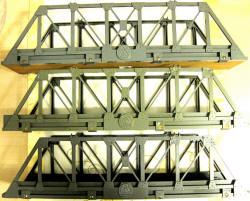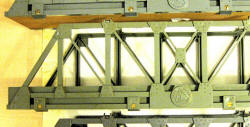

Girder Bridge R.78
|
The Tri-ang Girder Bridge (R.78) by Dave Coddington The
girder bridge first changed slightly from 1960, with the removal of the
four square ends. This change continued throughout the remainder of its
life. The next change was the removal of the moulded supports located at
the top girder corner plates & sections of the slot into which the
wooden base was located. The next moulding change was the removal of the
Rovex Scale Models symbol. It was released as a brown plastic version,
sold in Canada in the early 1970s. To date
I have discovered six different moulded versions of the girder bridge,
but who knows, other versions may come to light.
Different colour versions of the grey plastic also exist including a
dark green version, but are not listed here, only moulding differences. These
are the six versions:-
|
Thank's to Dave Coddington for allowing me to
use his article
 |
 |
|
| Some of the colour variations. The middle one is distinctly green not seen too well in this photograph | ||